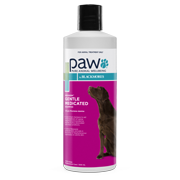
- PAW by Blackmores/
- A Guide To Perfect Your Pet's Health/
- Resources For Your Pet's Skin and Coat Health/
- Causes and Treatment of Hot Spots On Dogs


Hot spots on your dog don’t just look unsightly, they are likely annoying and painful for your pooch, too. The good news is that this skin condition – one of the most common in the doggy world – is treatable, and preventable, once you’ve determined the root issue.
What are hot spots on dogs?
“Hot spots are a type of dermatitis – an inflammation of the skin that is moist and raw, and develops an overgrowth of bacteria,” says veterinarian Dr Trish Santos-Smith. Some breeds are more susceptible to hot spots because of their thicker coats, which may trap this moisture.
Across all dog types, these flare-ups are particularly common on heads, limbs and hips, and are increasingly prevalent during warm, humid months of the year, when your pet might spend more time playing in water to cool off, and when bugs tend to proliferate.
Depending on their size and how itchy they are, hot spots can become raw, scabby, bulbous or even bleed or weep.
What causes hot spots?
“There’s usually a triggering factor that causes hot spots,” says Santos-Smith. These include:- Fleas, which may break the skin and cause excessive scratching
- Itchy skin or inflammation due to food or seasonal allergies
- Excess moisture on the skin, due to your dog not being towelled off correctly after a swim or bath
- Atopic dermatitis
- Dirty or matted fur
- Skin scrapes
- Stress or boredom, leading to your pet licking an area excessively
Are hot spots contagious?
“The most common type of hot spot – caused by bacteria – is not contagious,” says Santos-Smith. “So there’s no need to keep your pet away from other dogs, or humans.” However, some wounds, triggered by fungal infections, may be passed on to owners and other animals, which is why it’s important to seek advice from your vet, who can use a skin scrape to determine the cause of the hot spot.How to treat hot spots on dogs
If the hot spot is hairless, then Santos-Smith recommends cleaning it with antiseptic specific for this type of sore, soothing the irritation with a cool compress, patting it dry, then applying a wound gel or topical antibacterial cream (suggested by your vet) to the area.
“Often it will be covered in hair, however, in which case your vet may need to delicately shave or clip around the wound, allowing creams to be applied effectively,” she says. So that the cream has time to sink in and work its magic, Santos-Smith recommends applying it – then distracting your dog, either by taking it for a walk, serving up dinner or playing a game.
“This way they’ll forget about licking the cream off.” Your vet may also recommend an Elizabethan collar and oral steroids, to speed up healing and stop your dog irritating the area. If you get the right treatment, wounds can clear up in a few days to a week.
Most vets recommend avoiding the application of hydrogen peroxide to dry the area out – ouch!
How can you prevent hots spots?
Thankfully, there are some simple ways to ensure you avoid these unwelcome sores.
- Make sure your furry friend is fully up-to-date with flea treatments
- If your pooch is prone to allergies, look after its skin during high-risk months of spring and summer. Consider adding supplements or omega-3 fatty acids to your dog’s diet to boost skin health and reduce allergies, inflammation and itchiness
- Use the right shampoo and conditioner –" you may need something medicated and with antibacterial properties, or a wash specifically for sensitive skin
- Regularly brush and bathe your dog to remove irritants from the skin
- Keep boredom and stress at bay
- Dry your dog really well after any swim, bath or roll in a puddle to ensure no moisture remains on the skin.
Do I need to take my dog to the vet for a hot spot?
As with any health condition, monitor your dog and their response to the hot spot to determine whether a trip to the vet is required. If you’re able to identify the issue early, know the cause, can see your dog is not in pain and the wound area is shrinking, a visit may not be necessary. Keep the area clean and calm, and never apply bandages – the wound needs to breathe.
If there’s no improvement, or if the hot spot flares, seek your vet’s advice to determine the best ongoing treatment. Your vet will also be able to do a skin scrape to determine the cause of the hot spot, whether that’s the presence of parasites or a deeper skin infection, and will be able to prescribe appropriate oral medications or topical treatments.




